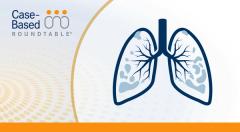
Adagrasib Shows Efficacy and Tolerability in KRAS G12C–Mutated NSCLC
Shirish M. Gadgeel, MD, MBBS, discusses the results of the KRYSTAL-1 trial trial of adagrasib in patients with KRAS-positive non–small cell lung cancer.
Shirish M. Gadgeel, MD, MBBS, division head for hematology/oncology and associate director for patient experience and clinical care at Henry Ford Health, discusses the results of the KRYSTAL-1 trial (NCT03785249) trial of adagrasib (MRTX849) in patients with KRAS-positive non–small cell lung cancer (NSCLC).
Adagrasib is a direct inhibitor of the KRAS G12C, like the approved agent sotorasib (Lumakras), Gadgeel says. In a phase 2 registrational cohort of the trial, 116 patients with NSCLC and confirmed KRAS G12C mutations were enrolled to receive adagrasib, 98.3% of whom had previously received chemotherapy and immunotherapy. The primary end point was objective response rate (ORR) assessed by blinded independent central review. Secondary end points included duration of response (DOR), progression-free survival (PFS), overall survival, and safety.
At median follow-up of 12.9 months, 48 of 112 evaluable patients had a confirmed response (42.9%). The median DOR was 8.5 months (95% CI, 6.2-13.8) and the median PFS was 6.5 months (95% CI, 4.7-8.4). It also had central nervous system (CNS) penetration, with an intracranial confirmed ORR of 33.3% (95% CI, 18.0-51.8) in 33 patients with treated stable brain metastases.
Adagrasib did show toxicities including nausea and vomiting; however, Gadgeel says it appeared better tolerated after a dose reduction from 600 mg twice daily to 400 mg twice daily, with only 7% of patients discontinuing treatment due to toxicity. The FDA is expected to announce its decision on granting accelerated approval to adagrasib by December 14, 2022.
TRANSCRIPTION:
0:08 | Adagrasib is also a G12C-specific direct inhibitor similar to sotorasib. In preclinical trials, it showed a long half-life, [meaning] sustained inhibition of KRAS G12C, and did show CNS penetration in preclinical models. Updated results from KRYSTAL-1, the phase 1 trial of the drug, were presented by Dr Alex Spira at ASCO [the American Society of Clinical Oncology Annual Meeting] this year. [These were] data on 116 patients. Baseline characteristics were similar to what one would expect in this population with a median age of 64. Almost all patients were current or former smokers, and over 95% of patients had adenocarcinoma histology. Ninety-eight percent of the patients had received both chemotherapy and [an] immune checkpoint inhibitor. And in this study, the drug demonstrated an ORR of 43% with a median PFS of 6.5 months and a median DOR of 8.5 months.
1:31 | The drug did have some toxicities, in particularly in terms of nausea [and] vomiting. The recommended phase 2 dose based on the phase 1 study [was] 600 mg [twice daily]. But it is important to note that 50% of the patients did require a dose reduction to 400 mg [twice daily], the next-lower dose. And with that dose adjustment, only 7% of the patients discontinued the drug because of toxicity.












































